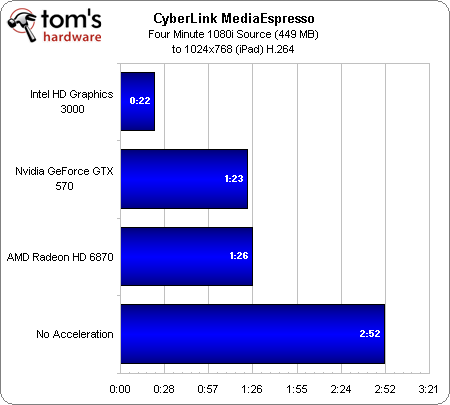Intel’s Second-Gen Core CPUs: The Sandy Bridge Review
Although the processing cores in Intel’s Sandy Bridge architecture are decidedly similar to Nehalem, the integration of on-die graphics and a ring bus improves performance for mainstream users. Intel’s Quick Sync is this design’s secret weapon, though.
Quick Sync Vs. APP Vs. CUDA
For now, we have a few media playback apps (decoders) and a couple of media conversion titles (encoders/transcoders) to play with.
CyberLink’s MediaEspresso has already been optimized to take advantage of AMD’s Stream (now called APP) and Nvidia’s CUDA API. Taken in the context of a machine without any hardware-based acceleration at all, you get a really freaking nice speed-up.
But the Quick Sync optimizations put Sandy Bridge in another league entirely. Converting an almost-500 MB source to 1024x768 for playback on an iPad takes a scant 22 seconds.
MediaConverter 7 presented more of a challenge. The pre-release version optimized for Quick Sync also accelerated AMD’s Stream API, but it wouldn’t recognize our GeForce GTX 570. Swapping out to the currently-shipping demo version didn’t give us a drop-down to turn on CUDA either, but it at least yielded results that show acceleration is definitely turned on. Arcsoft’s app has the added benefit of giving you a utilization monitor.
The result is fairly compelling. Without acceleration enabled, the iPad profile transcode took 1:35, tying up a Core i7-2600K at roughly 30% utilization. With Nvidia’s card installed, utilization jumped to 50%, but the job finished almost 20 seconds faster. A Radeon HD 6870 turns back lower utilization numbers and better performance results. But the Quick Sync-optimized path is most impressive, wrapping up in 41 seconds and barely touching the processor cores at all.
Unfortunately, you have to be using Intel's integrated graphics core in order to take advantage of Quick Sync. Neither MediaEspresso or MediaConverter are able to recognize the pipeline with a discrete card installed. So, if you're doing media work on a gaming PC, Quick Sync might not be an option for you.
Get Tom's Hardware's best news and in-depth reviews, straight to your inbox.
Current page: Quick Sync Vs. APP Vs. CUDA
Prev Page Sandy Bridge’s Secret Weapon: Quick Sync Next Page Blu-ray Playback And Video Performance-
cangelini MoneyFace pEditor, page 10 has mistakes. Its LGA1155, not LGA1555.Reply
Fixed, thanks Money! -
juncture "an unlocked Sandy Bridge chip for $11 extra is actually pretty damn sexy."Reply
i think the author's saying he's a sexually active cyberphile -
fakie Contest is limited to residents of the USA (excluding Rhode Island) 18 years of age and older.Reply
Everytime there's a new contest, I see this line. =( -
englandr753 Great article guys. Glad to see you got your hands on those beauties. I look forward to you doing the same type of review with bulldozer. =DReply -
joytech22 Wow Intel owns when it came to converting video, beating out much faster dedicated solutions, which was strange but still awesome.Reply
I don't know how AMD's going to fare but i hope their new architecture will at least compete with these CPU's, because for a few years now AMD has been at least a generation worth of speed behind Intel.
Also Intel's IGP's are finally gaining some ground in the games department. -
cangelini fakieContest is limited to residents of the USA (excluding Rhode Island) 18 years of age and older.Everytime there's a new contest, I see this line. =(Reply
I really wish this weren't the case fakie--and I'm very sorry it is. We're unfortunately subject to the will of the finance folks and the government, who make it hard to give things away without significant tax ramifications. I know that's of little consolation, but that's the reason :(
Best,
Chris -
LuckyDucky7 "It’s the value-oriented buyers with processor budgets between $100 and $150 (where AMD offers some of its best deals) who get screwed."Reply
I believe that says it all. Sorry, Intel, your new architecture may be excellent, but unless the i3-2100 series outperforms anything AMD can offer at the same price range WHILE OVERCLOCKED, you will see none of my desktop dollars.
That is all.


